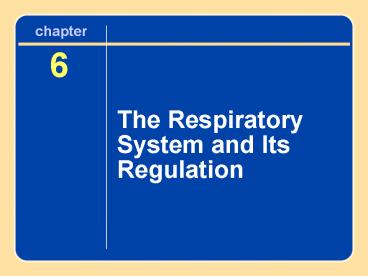The Respiratory System and Its Regulation - PowerPoint PPT Presentation
1 / 24
Title:
The Respiratory System and Its Regulation
Description:
6 The Respiratory System and Its Regulation External Respiration Pulmonary ventilation involves inspiration and expiration. Pulmonary Diffusion is the exchange of ... – PowerPoint PPT presentation
Number of Views:301
Avg rating:3.0/5.0
Title: The Respiratory System and Its Regulation
1
chapter
6
The Respiratory System and Its Regulation
2
External Respiration
- Pulmonary ventilation involves inspiration and
expiration. - Pulmonary Diffusion is the exchange of oxygen and
carbon dioxide between the lungs and the blood.
3
RESPIRATORY SYSTEM
4
Process of Inspiration and Expiration
5
Lung Volumes Measured by Spirometry
- Reprinted, by permission, from J. West, 2000,
Respiratory physiology The essentials
(Baltimore, MD Lippincott, Williams, and
Wilkins), 14.
6
Pulmonary Diffusion
- Replenishes blood's oxygen supply that has been
depleted for oxidative energy production - Removes carbon dioxide from returning venous
blood - Occurs across the thin respiratory membrane
7
Laws of Gases
- Dalton's Law The total pressure of a mixture of
gases equals the sum of the partial pressures of
the individual gases in the mixture. - Henry's Law Gases dissolve in liquids in
proportion to their partial pressures, depending
on their solubilities in the specific fluids and
depending on the temperature.
8
Partial Pressures of Air
- Standard atmospheric pressure (at sea level) is
760 mmHg. - Nitrogen (N2) is 79.04 of air the partial
pressure of nitrogen (PN2) 600.7 mmHg - Oxygen (O2) is 20.93 of air PO2 159.1 mmHg.
- Carbon dioxide (CO2) is 0.03 PCO2 0.2 mmHg.
9
Did You Know?
- The solubility of a gas in blood and the
temperature of blood are relatively constant.
Differences in the partial pressures of gases in
the alveoli and in the blood create a pressure
gradient across the respiratory membrane. This
difference in pressures leads to diffusion of
gases across the respiratory membrane. The
greater the pressure gradient, the more rapidly
oxygen diffuses across it.
10
Comparison of Pressure (mmHg) in the Pulmonary
and Systemic Circulations
- Reprinted, by permission, from J. West, 2000,
Respiratory physiology The essentials
(Baltimore, MD Lippincott, Williams, and
Wilkins), 36.
11
Anatomy of the Respiratory Membrane
12
Partial Pressures of Respiratory Gases at Sea
Level
13
Key Points
- Pulmonary Diffusion
- Pulmonary diffusion is the process by which gases
are exchanged across the respiratory membrane in
the alveoli to the blood and vice versa. - The amount of gas exchange depends on the partial
pressure of each gas. - Gases diffuse along a pressure gradient, moving
from an area of higher pressure to lower
pressure. - (continued)
14
Key Points (continued)
- Pulmonary Diffusion
- Oxygen diffusion capacity increases as you move
from rest to exercise. - The pressure gradient for carbon dioxide exchange
is less than for oxygen exchange, but carbon
dioxides membrane solubility is 20 times greater
than oxygen, so CO2 crosses the membrane easily.
15
Oxygen Transport
- Hemoglobin concentration largely determines the
oxygen-carrying capacity of blood. - Increased H (acidity) and temperature of a
muscle allow more oxygen to be unloaded there. - Training affects oxygen transport in muscle.
16
Oxyhemoglobin Dissociation Curve
17
Carbon Dioxide Transport
- Dissolved in blood plasma (7 to 10)
- As bicarbonate ions resulting from the
dissociation of carbonic acid (60 to 70) - Bound to hemoglobin (carbaminohemoglobin) (20 to
33)
18
ArterialVenous Oxygen Difference
19
Did You Know?
- The increase in (a-v)O2 difference during
strenuous exercise reflects increased oxygen use
by muscle cells. This use increases oxygen
removal from arterial blood, resulting in a
decreased venous oxygen concentration.
20
Factors Affecting Oxygen Uptake and Delivery
- 1. Oxygen content of blood
- 2. Amount of blood flow
- 3. Local conditions within the muscle
21
Key Points
- External and Internal Respiration
- Oxygen is largely transported in the blood bound
to hemoglobin and in small amounts by dissolving
in blood plasma. - Hemoglobin saturation decreases when PO2 or pH
decreases or if temperature increases. These
factors increase oxygen unloading in a tissue
that needs it. - Hemoglobin is usually 98 saturated with oxygen,
which is higher than what our bodies require, so
the blood's oxygen-carrying capacity seldom
limits performance. - (continued)
22
Key Points (continued)
- External and Internal Respiration
- Carbon dioxide is transported in the blood as
bicarbonate ion, in blood plasma or bound to
hemoglobin. - The (a-v)O2 differencea difference in the oxygen
content of arterial and venous bloodreflects the
amount of oxygen taken up by the tissues. - Carbon dioxide exchange at the tissues is similar
to oxygen exchange except that it leaves the
muscles and enters the blood to be transported to
the lungs for clearance.
23
Regulators of Pulmonary Ventilation at Rest
- Higher brain centers
- Chemical changes within the body
- Chemoreceptors
- Muscle mechanoreceptors
- Hypothalamic input
- Conscious control
24
Pulmonary Ventilation
- Ventilation (VE) is the product of tidal volume
(TV) and breathing frequency (f) - VE TV x f































